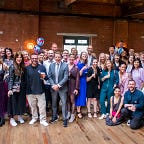How smart might our cities become?
By 2050, Earth’s urban population is predicted to double. There will be 9.8 billion people — two billion more than now — and two-thirds will live in cities, up from the current 56%. We’ll need more infrastructure, healthcare, housing, energy, public services, water, food and more.
To cope and to thrive, our cities will need to become smarter, using interconnected technology to run efficiently, optimise resources and reduce costs, so that they are liveable, resilient, sustainable, inclusive and prosperous.
Using DALL-E to generate these images our design team has imagined a speculative future city, fuelled by joined-up technology and data. What might it look like? How would we experience it? What challenges would we pose?
We’ve created three scenarios for a 2050 citizen and one thing is clear: with our accelerating reliance on technology, taking a human-centric approach will mean rethinking digital products and services so that they’re less harmful to us and better serve both people and the planet.
thread: a city-wide interface
New technology enables our smart city to harness data in real time through its environment, objects and inhabitants. For people to interact with the city and utilise this data, we imagined thread, a democratised, open-source master operating system which is owned, managed and optimised by the people, enabled by blockchain/post-blockchain technology.
It’s personalised, intuitive, secure and available to everyone, to access healthcare, transport, shopping, information, entertainment and everything else needed. thread is overlaid on to our cities and experienced through personal and city-wide AR devices, recessive when not in use but expansive and instant whenever or wherever needed.
Healthcare
The global market size for AI in healthcare is predicted to be £28m by 2025. In our 2050 city, Ai use in healthcare and diagnosis has become widespread. City-wide health scan pods can provide instant diagnosis for mild and moderate conditions, nutrition and lifestyle advice, prescriptions and a digital health record, and can sync people’s personal health data with the healthcare system. The pods have relieved much of the burden of check-ups and diagnosis created by the ageing and increasing population. Where the human touch is needed (e.g serious illness, social care, mental health), the pod refers the user to in-person appointments.
Mobility
All of the city’s civic infrastructure and public spaces can collect data, communicate with each other and respond to real-time changes. Single-person transport systems are widespread and vehicles are fully electric and automated.
The city centre is a car-free zone, for people’s safety and to protect the environment. Individual vehicle ownership is a thing of the past and car makers have shifted to become mobility service providers.
If the health pod suggests supplements for Clara she can opt to be directed to the nearest vehicle to collect them. The car is connected to travel and retailers’ data so it takes her to the nearest store the fastest way. On the way she books an evening yoga class.
Sustainability
Developments in neuroscience and AI mean we can measure the reactions of animals and plants to their environment and translate it into dialogue. This deep connection between nature and humans means buildings and infrastructure can be designed sympathetically. Homes can be adapted in consultation with the local environment as plant and animal reactions are monitored and turned into human language. Real-time data prompts Clara to help her local bee population.
This scenario isn’t intended as a north star; it’s meant to open up thinking about the direction urban life might take, the part organisations might play in responding to trends shaping the future. When we can expand our view, we can better anticipate change and potential threats, and see new opportunities.
This is an excerpt from our latest book Purpose: Built, it’s all about making change happen and designing a brighter, better future. If you’d like a copy of request one here.
Authors/ designers: Felix Kirk + Sam Pickering
Magnetic is a design and innovation company that helps design better futures. We’ve worked with global businesses to uncover the insights they need to stay in touch with customers’ shifting expectations, priorities, needs, behaviours and preferences. To find out more or to talk to us about foresight, contact Sophie Little, Executive Director at Magnetic at sophie.little@wearemagnetic.com.
